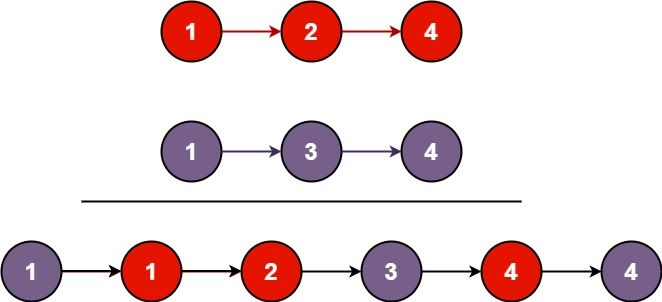# 合并两个有序链表
将两个升序链表合并为一个新的 升序 链表并返回。新链表是通过拼接给定的两个链表的所有节点组成的。
示例 1:

输入:l1 = [1,2,4], l2 = [1,3,4]
输出:[1,1,2,3,4,4]
示例 2:
输入:l1 = [], l2 = []
输出:[]
示例 3:
输入:l1 = [], l2 = [0]
输出:[0]
提示:
- 两个链表的节点数目范围是
[0, 50] -100 <= Node.val <= 100l1 和 l2 均按 非递减顺序 排列
## template
```python
class ListNode:
def __init__(self, val=0, next=None):
self.val = val
self.next = next
class LinkList:
def __init__(self):
self.head=None
def initList(self, data):
self.head = ListNode(data[0])
r=self.head
p = self.head
for i in data[1:]:
node = ListNode(i)
p.next = node
p = p.next
return r
def convert_list(self,head):
ret = []
if head == None:
return
node = head
while node != None:
ret.append(node.val)
node = node.next
return ret
class Solution:
def mergeTwoLists(self, l1: ListNode, l2: ListNode) -> ListNode:
h = ListNode(0, None)
p = h
while l1 and l2:
if l1.val < l2.val:
p.next = l1
p = l1
l1 = l1.next
else:
p.next = l2
p = l2
l2 = l2.next
if l1:
p.next = l1
else:
p.next = l2
return h.next
# %%
l = LinkList()
list1 = [1,2,4]
list2 = [1,3,4]
l1 = l.initList(list1)
l2 = l.initList(list2)
s = Solution()
print(l.convert_list(s.mergeTwoLists(l1, l2)))
```
## 答案
```python
```
## 选项
### A
```python
```
### B
```python
```
### C
```python
``` 